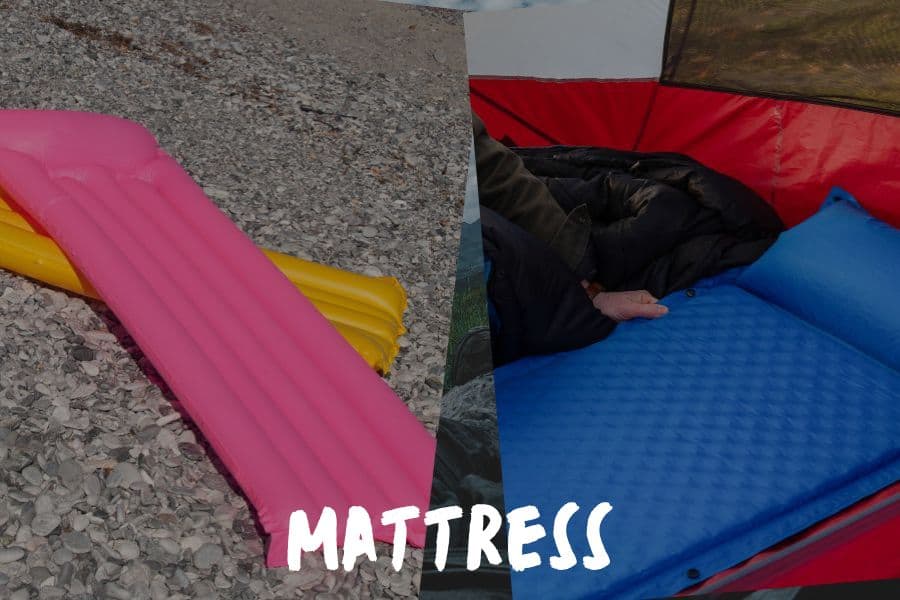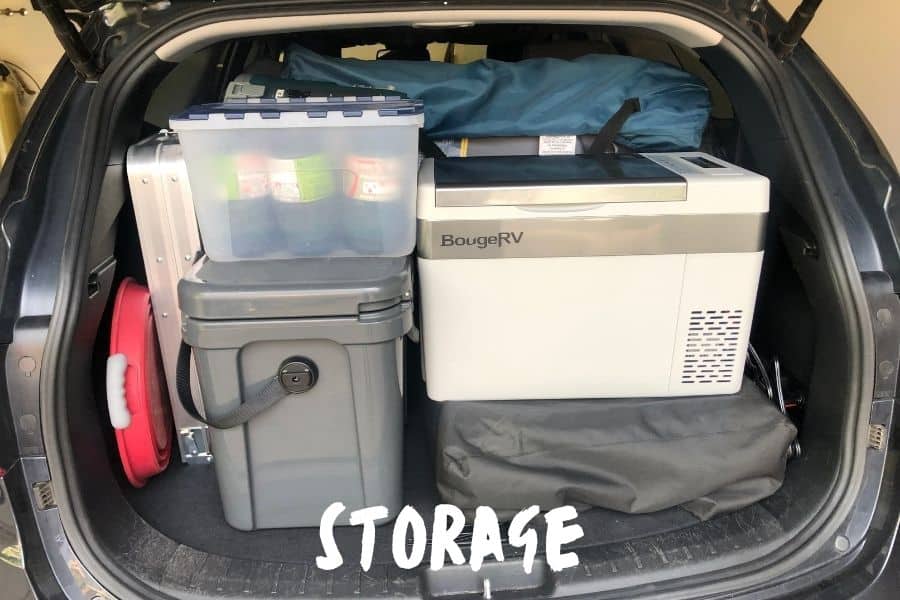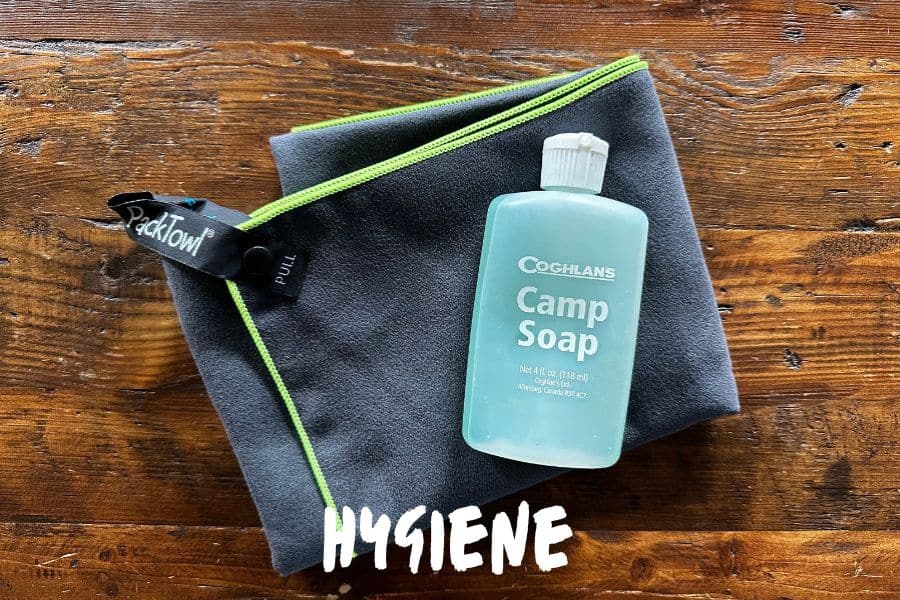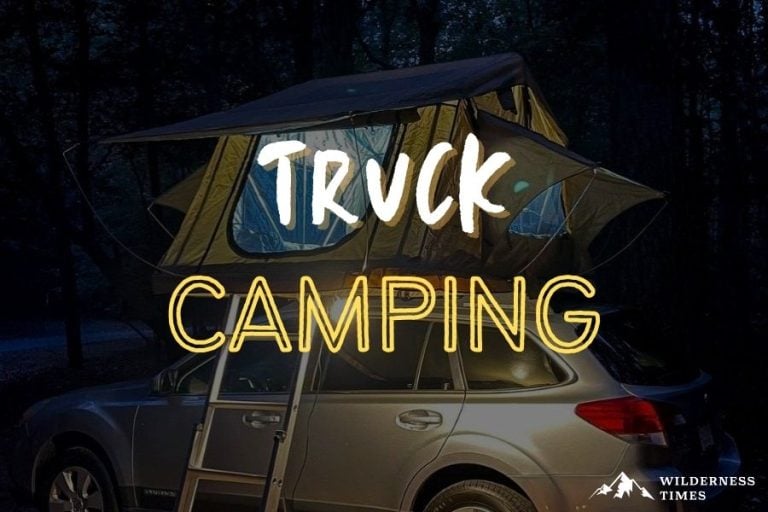Did you ever dream about visiting a bunch of different places on one camping trip?
Well, when you own a truck, it’s possible!
Obviously, things are a tad more complicated than just packing a bag or two and hitting the road. But, don’t worry – with the right information and a bit of preparation, it’s fairly straightforward.
In this article, I’ll cover everything you need to know before heading off on a truck camping adventure.
So read on!
Table of Contents
ToggleWhat Makes Truck Camping So Great?
It’s simple. You can enjoy all the beauties of camping but on wheels.
So for instance, one day you can sleep on the beach, while the next you’re up in the mountains enjoying the breeze.
And the best thing is – you’re not carrying any stuff on your back!
Another thing I like about truck bed camping is the coziness.
Don’t get me wrong – I love tents, but a 9-to-5 job has taken a toll on my back. Sometimes, I just want to sleep just like I would at home, but with different surroundings. And that’s the beauty of truck camping.
Finding A Campsite

When you’re on four wheels, you can go just about anywhere!
Okay, when it comes to campgrounds, some are tent-only, but there are plenty that also accommodate trucks and RVs.
But why limit yourself to campgrounds?
With a pickup truck, you can go to all those places that are too far away to get to by foot.
You can just open a map, close your eyes and point your finger at a random destination.
If you don’t mind not having a restroom and unlimited water supply, be adventurous. Choose a place you’d never go otherwise.
Different Truck Camping Methods
The main question with truck camping is – where to sleep?
Luckily, you have plenty of options.
Ground Tent
Many first-time truck campers opt for sleeping in a tent.
It’s the least expensive truck camping method, and if you want to take a quick ride to a store or a gas station, you don’t have to pack your whole camp up.
But in my opinion, this method is basically just classic tent camping.
Truck Tent
This type of tent pops up in your cargo bed.
So, you’re sleeping in a tent, but with some extra benefits. The first being that you’re off the ground, on a flat surface. That way, you don’t have to worry about rough terrain or dirt getting inside.
Plus, you don’t have to worry about snakes or critters getting inside, as you would with ground tents.
But is there a disadvantage to a truck tent?
Sure there is.
If you want to take a short trip with your truck, you have to pack the whole thing up. So this isn’t a suitable option for those who like to drive around to different locations during the day.
Camper Shell
Last but not the least, we have the camper shell.
While more expensive than the other two methods, a shell gives you a completely different experience.
Basically, it’s a proper roof over your head that keeps both you and your gear safe and dry. Most models have windows, which makes you feel more at home. Plus, you can lock it while you’re out hiking.
They’re pretty lightweight, so your gas consumption won’t increase like it would with a trailer.
Sure, they cost more than a tent, but it’s a worthy investment with all the benefits they bring.
Essential Gear
If you decide on sleeping in a ground tent, most of your gear won’t differ much from a standard camping trip. In this case, you just have more storage space.
But, if you choose to sleep inside a truck, there are a few basic things to keep in mind.
Mattress

Let’s start with the basics.
In this case, it’s what you’re going to sleep on.
In my late teens, I remember I could put my sleeping bag on just about any surface, and I’d fall asleep without a care in the world. Nowadays, I’m not going anywhere unless my back has proper support.
Sleeping Pads & Air Mattresses
For truck camping, you can use the same things you’d probably use inside a tent – a sleeping pad or an inflatable mattress.
These two options are rather similar, but there certainly are some differences.
When it comes to comfort, an air mattress wins over a sleeping pad all the way. With some blankets and pillows, you’ll feel like you’re sleeping in your own bed.
But, in my opinion, its advantages end there. An air mattress gets as cold as its surroundings. A pad, on the other hand, generally provides good insulation. Besides, it takes up less space and it’s designed to be quite durable.
Innerspring & Foam Mattresses
There are more sleeping options, though.
There are innerspring and foam mattresses on the market that are specially designed for truck bed camping. They kinda remind me of the mattresses we have at home, just a bit smaller.
Some models fold up, which allows you to make the best use of the space you’ve got. You can fold it up during the ride, and open it when it’s time for a good night’s sleep.
But the best thing is – they don’t have to cost a pretty penny.
On the market, there’s a mattress for anyone’s budget. So if you plan on becoming a full-fledged truck camper, this is something worth investing in.
Finally, I have to mention memory foam mattresses, too. If you own one at home, you know these make you feel like you’re sleeping on a cloud.
And while that’s all fine and dandy, these practically turn into bricks when it’s really cold. And if that happens, you’ll be more warm and comfortable sleeping on the base of your truck with no mattress at all.
Sleeping bag

During warmer parts of the year, you can get by with the old, thin sleeping bag you have laying around your attic. In fact, you can probably just put any blanket on and you’ll be warm at night.
But as the days get colder, you’ll want to have a proper sleeping bag at your disposal.
Ideally, you want a sleeping bag with good insulating ability. If you get hot during the night, you can always unzip it and stick one leg out to cool down. If you get cold, on the other hand, you’ll end up waking your camping buddy when you’re frantically searching for more clothes to put on.
Unless it’s under 30 degrees outside, a rectangular bag wins over the mummy easily. Since you’re already enjoying the amount of room you have sleeping in a truck, why get a sleeping bag that restricts your movement?
Pillow

When it comes to truck camping, forget about camping pillows.
Instead, just bring the one you use at home. Especially if you’re picky about your pillows, like me. I mean, one pillow won’t take up that much storage space, so why trouble yourself with inflatable ones?
If you prefer memory foam pillows, keep in mind what I said above. In freezing temperatures, they turn into stone.
Power Inverter
You’re not exactly fully disconnecting in nature if you’re driving your truck around. And since that’s the case, let’s make the best use of that cigarette lighter adapter in your vehicle, and keep all your electronics charged.
To do that, you need a power inverter that converts DC power into AC power. These are pretty affordable and really should be a staple in your equipment inventory. Just keep in mind that different car batteries have different output voltages, so make sure to get the right one.
Another friendly warning – avoid using it when the outdoor temperatures are above 100°F. While most inverters nowadays have built-in overheating protection, there’s always a risk of damage.
Storage

Obviously, a truck allows you to pack way more than you would for backpacking. But keep in mind that you’re still driving a truck, not a bus. Your storage space is limited, and you need a good method to keep everything organized.
For clothes, I’d recommend duffle bags. The soft design makes your job easier when trying to fit them in between your mattress and camping chairs, for example. What’s more, they don’t take up unnecessary space when empty or half-full.
For just about anything else, plastic totes are great for storage. From dry food to camping gear, they make it super easy to keep all your stuff organized.
These are just a few ideas for truck camping beginners. If this is something you decide on doing more often, you can modify your truck to suit all your needs. There are endless ideas, you just need to have the time and money to make it all.
With plywood and some tools you have laying around at home, you can cleverly make use of small spaces. For instance, you can make a sleeping platform, with a bunch of drawers underneath that that once slid out, turn into counters and tables.
Oh, and don’t forget about water containers.
You need to make sure you have enough water, especially when camping in a remote area. You’re going to need at least a gallon of water per person each day.
Then, of course, you’ll need water for hygiene, too. I’d advise getting at least a 5-gallon jug just for that.
Food

To me, the best thing about truck camping is being able to take a variety of cooking supplies with you to the wilderness.
I’m guilty of enjoying fancy meals in nature.
After I tried making pizza for the first time, it became my traditional camping dinner.
The tailgate of your truck can double as counter space. Just cover it with a piece of plywood, and you have enough room to roll out your pizza dough, chop some veggies, etc.
For truck camping, a portable camping stove is a must. Especially during warmer months. That way, you don’t have to build a campfire just to make a meal.
What kind of stove?
One that uses propane, ideally. This type of fuel performs well in different weather conditions and you can buy a propane bottle in just about any store or gas station.
I’d also recommend getting one with two burners. That way, you can create different heat zones, so you can practically make just about any meal you’d make at home.
A cooler is another necessity. There are tons of different models on the market to choose from. You can even find 12V coolers that you can plug into your vehicle.
Hygiene

We can’t forget about hygiene while on the road.
Bathing in the wilderness can be challenging. But, unless you want to use your sweat as your main weapon against possible bear attacks (it won’t work anyway) – it can be done.
Showering
Since your water source is limited, you need to learn to conserve it as much as possible.
You might leave the shower on while you’re shampooing your hair at home, but that won’t work in the wilderness.
Actually, you should probably forget about washing your hair altogether. Unless a bird drops some “good luck” on your head (if you know what I mean), you shouldn’t waste water on a hair wash. If you can’t stand greasy hair, you can always use dry shampoo.
When it comes to showering, it’s time to learn the skill of a G.I. bath. In other words, get wet, turn off the water while scrubbing, and then rinse quickly. Believe it or not, this can all be done in less than 2 minutes.
You can also try sponge bathing. You just need a bucket of water (a quarter of a gallon will do), a sponge and soap. Just make sure to use biodegradable soap, to stay in accordance with Leave No Trace principles.
For those who want to feel more at home, there’s a variety of portable showers available on the market. From compressor and battery-powered models to those that work using only gravity, you can find whatever you need.
And in case you can’t get enough privacy – like in crowded campgrounds, a shower tent is a must.
The Number Two
I know a lot of people are wondering this, but feel uncomfortable asking – where do you go in nature?
Well, there are a couple of options available.
If legal restrictions allow it (this can be checked at a local ranger station), you can dig a cathole and do it there. Just make sure to use biodegradable paper, and bury it all when you’re done. Another option is to use bag wags, just like we do with our dogs.
But since you’re truck camping, you can also get a portable toilet. They’re pretty affordable, and if you use landfill-approved biodegradable bags together with the poo powder, you can dispose of it in just about any trash can you find.
Safety And Repairs
When camping in a remote area, it’s unlikely you’ll encounter other people to help you with whatever issues you might have. So, you need to be well prepared.
The most important thing to have with you is probably a first aid kit. From tick bites and cuts to more serious injuries, you need to have the proper tools for emergency assistance, especially when hospitals are far away.
A tire repair kit is just as important. The last thing you want is to find yourself with a flat tire in the middle of nowhere. Not only can it take hours until road assistance arrives, but it might cost you an arm and a leg as well.
Always carry duct tape with you. This simple tool can take care of a lot of minor repairs, at least until you get home.
After learning the hard way, I always have a shovel packed with me. Not only for digging a cathole, but this thing is also a lifesaver in case you need to clear a driveway or even get yourself out of the mud.
I used to not give shovels too much credit before, either. Then, I ended up with my car stuck in the snow for hours, waiting to get rescued. Now, I don’t leave my house without a full survival kit.
Better safe than sorry.
Finally, if you’re camping in bear country, you should always have bear spray close at hand. While bears don’t usually like human company, they might pay a visit to your camp in search of food.
To Sum Things Up
I could probably talk for days when it comes to this topic, but I believe this article sums up everything you need to know before your first truck camping trip.
From camping methods to essential gear, if you follow these tips you’re sure to have everything you need to make your truck bed your new home away from home. Because if you ask me, there’s no better way to explore nature on four wheels than truck camping.
So go out and enjoy the wilderness!
Also see: Different Types Of Camping – 13 Awesome Ways To Spend The Night In Nature


